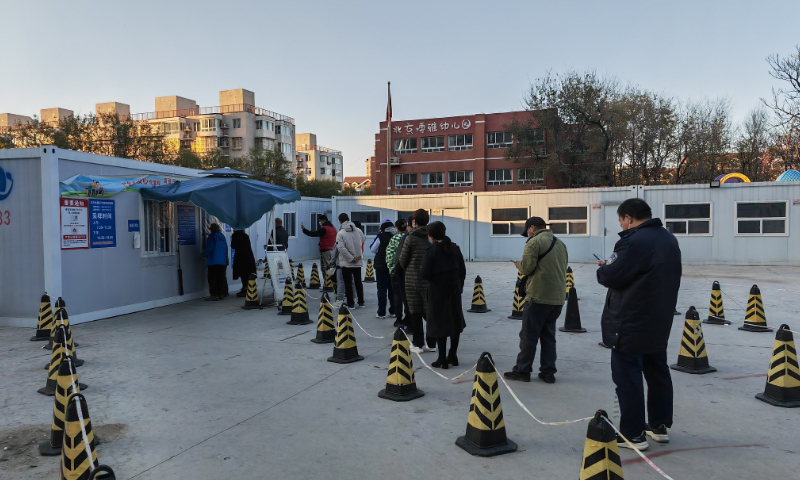
Residents in Beijing line to take nucleic acid tests on November 15, 2022. Photo: VCG
Omicron BF.7 has become the
main strain in Beijing's latest COVID-19 flare-up, with the virus possessing the strongest infection ability across the family of Omicron sub-variants in China and posing the risk of hidden spread, causing difficulty on virus prevention and control, according to Beijing Daily on Monday, citing a Chinese medical expert.
The Omicron BF.7 was from outside Beijing, and is different to other sub-variants circulating in other parts of China. Compared with the BA.1, BA.2 and BA.5 variants detected previously, Omicron BF.7 has more immune escape capability, a shorter incubation period and faster transmission rate, Li Tongzeng, a medical expert at Beijing's Xiaotangshan Hospital said.
"The basic reproduction number (R0) for Delta variant is around 5 to 6, that of Omicron BF.7 has exceeded 10," Li said.
It means that the stronger the transmission capacity of the infectious disease is, the faster the number of infected persons increases. The R0 of the current Omicron BF.7 in Beijing can reach from anywhere between 10 to 18.6 persons, according to Li.
On Sunday, Beijing reported 840 new local cases and 3,048 asymptomatic carriers, according to local health officials, with 474 cases detected at the community's level.
As to why the number of new cases and cases detected outside quarantine quarters keeps increasing these past days, Li said the second generation of cases can appear in only 2-3 days. Some cases may be missed under the previous nucleic acid testing frequency, meaning transmission has already occurred before positive cases are identified.
Although the infectivity of the virus increased and the intergenerational time became shorter, the time to turn negative after infection was still between 7-10 days, according to Li.
However, the general detected symptoms after Omicron infections are mild, which often leads to people being less vigilant, Li noted.
The symptoms caused by BF.7 are similar to other Omicron sub-variants, primarily with upper respiratory symptoms. Patients may have fever, cough, sore throat and other symptoms, with a minority of cases experiencing vomiting, diarrhea and other symptoms.
Beijing has vowed to continue to make prevention and control measures more "scientific, rational, targeted and effective".
A neighborhood in a Beijing community recently allowed a two-year-old child who tested positive for COVID-19, but who has the condition of asthma, to stay at home for observation with the parents, according to media reports, representing a new balanced approach to prevention and control.
The ninth edition of the country's COVID-19 control protocols said positive cases should be placed under centralized quarantine or sent to designated hospital for treatment.
The
protocols and the 20 optimized measures require effective coordination and information sharing among the investigation, transferring and testing groups to control sudden outbreaks, according to Wang Liping, a research fellow at the Chinese Center for Disease Control and Prevention.
For asymptomatic carriers themselves, most people are willing to stay at home for medical observation, Li said. But as a physician, Li has seen some elderly people who were infected with COVID-19 and developed into severe symptoms, exacerbating their underlying conditions.
But people who live in the same community with seniors, confirmed cases, or those working in essential jobs may have a different view.
It would be ideal if the policy is able to be targeted to within one specific family or individual, Li said. However, it requires health workers to assess the community environment, household ventilation, sewerage and waste treatment factors to ensure that surrounding residents are safe, Li added.
"The reality is that there is no reliable method for assessment, and many communities are not able to do so, meaning the strategy of centralized quarantine is a practical consideration," Li said.
Beijing has adopted different treatment methods for COVID-19 patients. There is currently no medication or treatment for asymptomatic cases. Medical staff have been instructed to distinguish between those who are at high risk of severe illness, such as the elderly, people with underlying conditions and other people with low immunity, and special groups including pregnant women who will be monitored more closely, according to Li.
For mild and common cases, medical staff have been adopting medical treatment based on patient need, Li said.




